Utilizing modern analytical techniques to preserve a 19th century royal storage box from Bali.
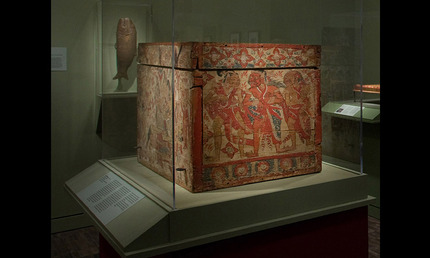
During the planning process for the exhibition Bali: Art, Ritual, Performance, this decorated wood box was examined by conservators to determine if it could be safely displayed. Several condition problems were noted, and it was decided that conservation treatment would improve the appearance and stability of the box. A conservation treatment includes a number of steps and can take many hours. In this case, the box was treated over several months during the autumn of 2010. This decorated wood box was probably used to carry sacred textiles or other valuables in one of the courts of southern Bali. Its paintings, made with traditional stone-ground pigments, are among the many that illustrate themes from an important series of stories also performed in traditional dance dramas. The Panji tales, originating in East Java in perhaps the twelfth or thirteenth century, were named after the legendary prince who features widely in them. Versions spread through much of Southeast Asia. Especially popular within the Balinese courts, these tales lost favor after the Dutch conquest. In the episode illustrated on this box, a princess, Rangkesari, is kidnapped to become a wife of the king of Lasem, but she threatens suicide to avoid this fate. The king and his allies eventually enter into battle with Prince Panji and Rangkesari’s brother but are defeated. For more images of this box, see Royal storage container 2007.4.A-.B.
Every conservation treatment begins by examining the condition of the artwork. Documentation includes photography, written reports, materials analysis, and testing. The results become a part of the permanent records of the museum and serve as a valuable resource for future conservation as well as a safeguard and comparative reference throughout the treatment process. The images below show the various types of information a conservator may look for and record.
The Royal storage container is fabricated from thick wood boards, joined together using a simple construction of dovetail joints and supplementary pegs.
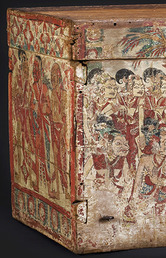
Before color was applied, the container was prepared with a calcium-based white ground. The low angle of the light reveals that details of jewelry and costume were built up with a thicker, textured surface to simulate the heavy jewelry and ornaments worn by the Balinese. Textured areas were painted yellow to simulate gold.
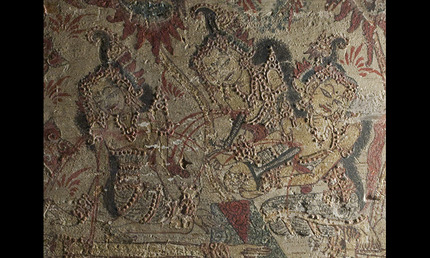
The paints used to decorate the box were made from mineral pigments and natural gum binders. When very little binding medium is used, the paints are flat and matte in appearance. Such paints are particularly fragile and easily damaged. This side shows extensive paint loss.
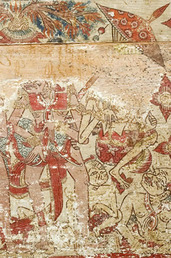
To a conservator, the condition of an object offers many clues to how the object was used and valued. The box has stains along the lower edge, suggesting exposure to water. The greater degree of wear on one side of the box (photo at left) and the dark, resinous drips along the length indicate that the box was stored vertically for some time.
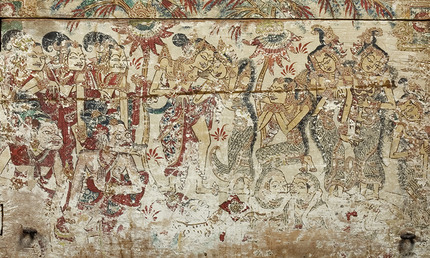
The image to the left, taken in normal light, shows the same scene as the image to the right. Blue arrows indicate areas of modern restoration. The orange arrow points to a dark, resinous drip, and the yellow arrow indicates water stains. Under ultraviolet light in the image to the right, areas previously retouched with contemporary paints appear dark, and are easily distinguished from the characteristic bright fluorescence of the original binder and paints.

Identification of the materials can often help to date an art object, and provide important information on how to better treat and care for it. Here, x-ray fluorescence spectroscopy (XRF) and optical polarized light microscopy (PLM) were used to identify the pigments used to decorate the container. XRF reveals the elemental composition of a material, while microscopy can help identify pigments through their structure and colors.
Materials identification can also provide important safety information. Analysis of the painted surfaces revealed the presence of arsenic in many areas. Arsenic was commonly used as an insecticide in the 19th century, and was probably applied by a previous owner. Protective gloves and safety equipment must be used when handling this object.
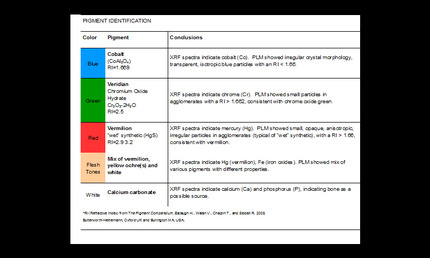

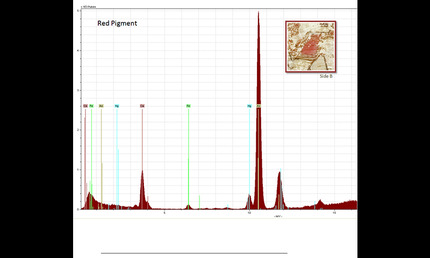
Treatment began with the important step of consolidating the powdery, flaking paint surface.Consolidation typically involves introducing an adhesive into the paint layer to prevent further loss of the painted image.
The adhesive used for this process was selected carefully. A number of factors including chemical behavior, ageing properties, and appearance were taken into consideration, and the adhesive was formulated to allow the best possible adhesion without changing the color or gloss of the paint. The adhesive was tested on tiny areas of the box, and the procedure adjusted until it was certain that the method was safe and effective.
Finally, the consolidant was applied to the surface of the box using a fine brush. Some areas were consolidated more than once, or with different formulations, depending on the extent of flaking and powdering of the original surface.
Once the consolidation was complete, it was decided that some of the most distracting areas of paint loss should be toned. The goal was to minimize the most disfiguring damage while keeping alterations to a minimum. Before adding any colored paint, a transparent layer of resin was applied so that the new paint can be removed if desired.
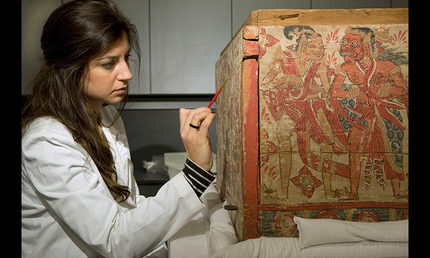
The extent to which lost images are restored is always a critical concern in conservation treatments. This step was discussed among conservators and curator before proceeding. Only certain types of damage were toned, including the exposed white ground layer, the dark resinous stain across the scene, and large losses in brightly colored areas. These details show how selective toning can unify the image without excessive intervention.
